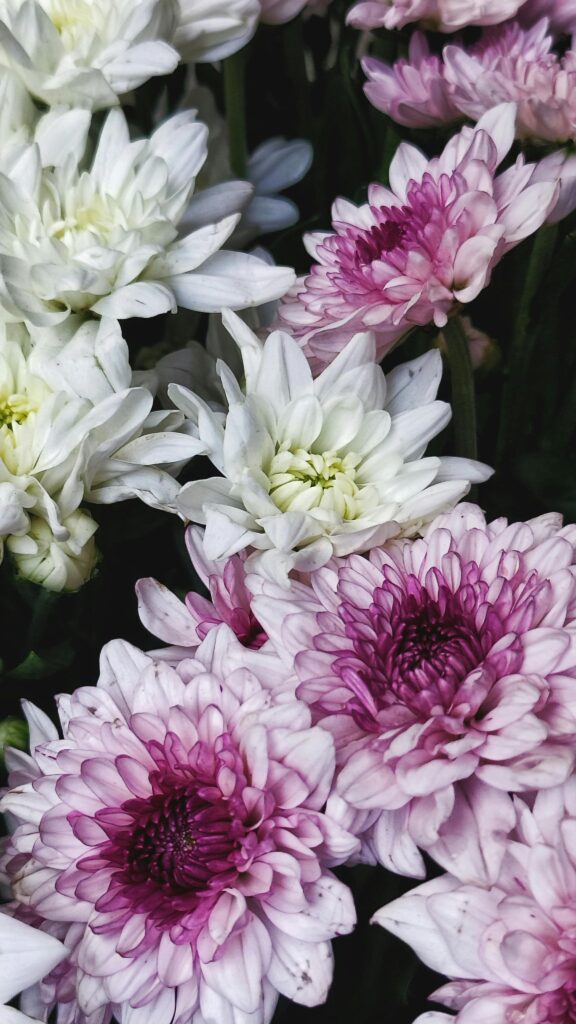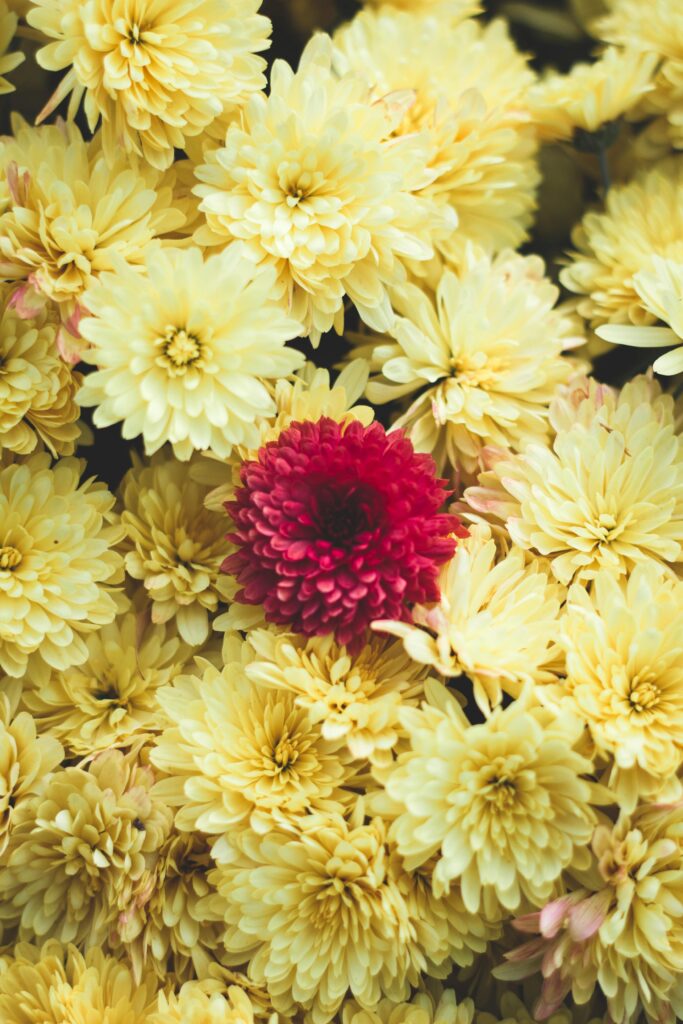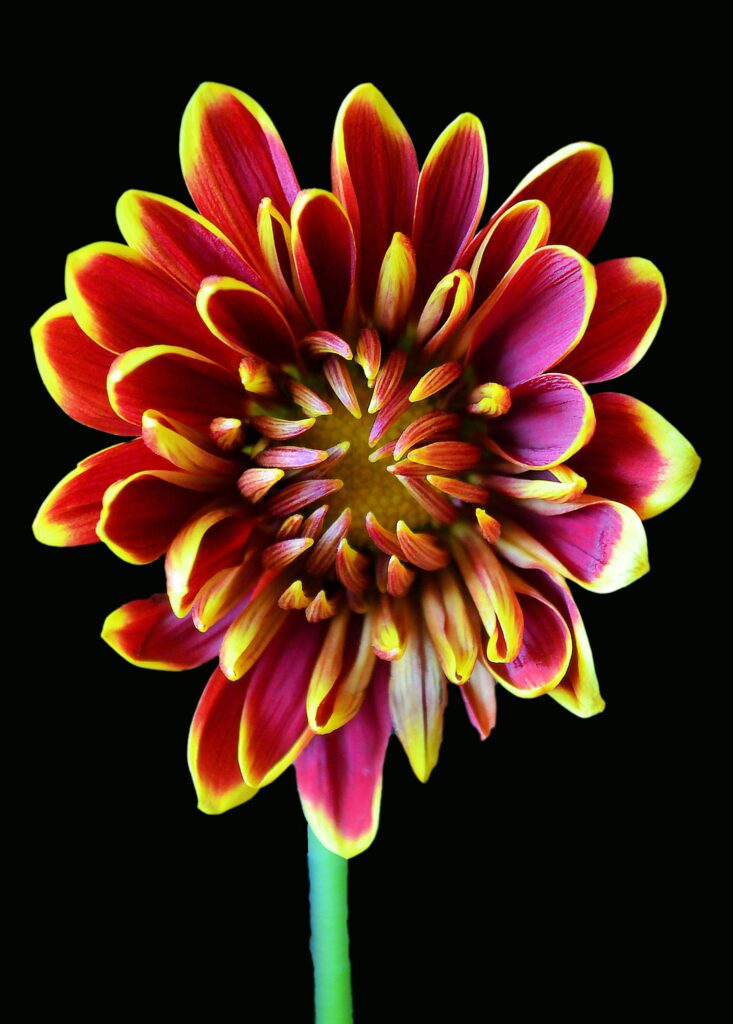
One of the most cherished autumnal flowers is the chrysanthemum, also known as the mum. When most other plants have finished flowering, chrysanthemums (Chrysanthemum morifolium and related species) add warmth and charm to gardens with their rich colours, varied bloom shapes, and enduring beauty. These blooms, which range from bright yellows to rich reds and purples, are a gardener’s favourite for prolonging the beauty of the season.
Table of Contents
A Brief Introduction to Chrysanthemums
Often referred to as “mums,” chrysanthemums are members of the Asteraceae family, which also includes sunflowers and daisies. Chrysanthemum, the genus name, means “golden flower” and is derived from the Greek words “chrysos” (gold) and “anthemon” (flower). Although their name suggests that they were originally yellow, chrysanthemums can now be found blooming in nearly every color, including red, pink, white, orange, purple, and even green.
Chrysanthemums are native to East Asia, particularly China, and have been grown for over 2,500 years. They gradually made their way to Europe, Japan, and finally the US, where they were widely used in floral arrangements, gardens, and cultural customs.
Chrysanthemum History
Around the 15th century BCE, chrysanthemums were first grown in China for their aesthetic qualities as well as their therapeutic benefits. Chrysanthemum flowers were thought by ancient Chinese herbalists to have the ability to lower fever, cleanse the blood, and increase longevity.
Chrysanthemums were introduced to Japan in the eighth century and soon came to represent the imperial family. The flower became the official seal of the Japanese emperor, and the monarchy is still known by its poetic name, the “Chrysanthemum Throne.”
Chrysanthemums reached Europe via trade routes by the 17th century. Their diversity captivated botanists and gardeners, who started breeding new varieties. Since their introduction to the United States in the 18th century, chrysanthemums have grown to be a popular flower and garden plant, particularly in the fall.
Global Cultural Significance
The fact that the meaning of chrysanthemums varies by culture and geography is among their most intriguing features.
China: A representation of nobility, vigor, and longevity. Along with bamboo, orchids, and plum blossoms, chrysanthemums are considered the “Four Gentlemen” of Chinese art and are frequently featured in traditional poetry and paintings.
Japan: A representation of joy, the sun, and the emperor. One of Japan’s five holy holidays, Chrysanthemum Day (Kiku no Sekku), is observed annually.
United States: Known as a happy flower that symbolizes happiness and optimism. Particularly around Thanksgiving, chrysanthemums are frequently used in bouquets, gardens, and festive décor.
Europe: Chrysanthemums are connected to mourning and remembrance in many European nations. Particularly in France, Belgium, and Italy, they are frequently buried with them or used at funerals.
Australia: Because mothers are known as “mums,” they are given this as a Mother’s Day gift.

Chrysanthemum Colors and Their Meanings
Like roses, chrysanthemums carry symbolic meanings based on their color:
- Red: Love and deep passion
- White: Honesty, loyalty, or remembrance (in some cultures, white chrysanthemums are used in funerals)
- Yellow: Friendship, joy, but sometimes unrequited love
- Pink: Affection and admiration
- Purple: Elegance, nobility, and royalty
- Green: Renewal and vitality
Why Chrysanthemums Are So Special
- Seasonal Stars: When other flowers start to fade, they add colour with their late summer and fall blooms.
- Colour Variety: Yellow, red, orange, pink, white, and purple are among the available hues.
- Symbolism: In many cultures, they stand for happiness, longevity, and friendship.
- Versatility: Perfect for cut flower arrangements, pots, borders, and garden beds.
Popular Types of Chrysanthemums
1. Single or Daisy Type: straightforward blooms with petals encircling a central disc.
2. Pompon Mums: Tiny, globe-shaped flowers.
3. Spider mums: gracefully curved, long, thin petals.
4. Quill Mums: These plants have tubular petals that give them a striking, spiky appearance.
5. Anemone mums: Petal rows encircle cushion-like centres.
Growing Chrysanthemums: Step-by-Step Guide
1. Climate and Location
Chrysanthemums need at least five to six hours of full sun each day. They are ideal for autumn gardens because they grow well in mild to cool climates.
2. Soil Preparation
The best soil is fertile, well-draining soil that has been enhanced with compost. The ideal pH range is 6.0–7.0, which is slightly acidic to neutral.
3. Planting
For robust root development prior to autumn blooming, plant mums in the spring. To guarantee adequate airflow, place plants 18 to 24 inches apart..
4. Watering
Avoid making the soil soggy, but keep it evenly moist. To avoid fungal issues, water the base.
5. Fertilizing
Throughout the growing season, fertilise with a balanced fertiliser every two to four weeks.
6. Pinching
To promote bushy growth and more blooms, pinch back the growing tips in late spring and early summer.

Benefits and Uses of Chrysanthemums
- Ornamental: Illuminate indoor areas, patios, and gardens.
- Cut Flowers: They are popular in floral arrangements because they last a long time in vases.
- Medicinal: Because of its anti-inflammatory and cooling qualities, it is utilised in traditional Chinese medicine.
- Tea: In Asia, chrysanthemum tea is well-liked for its health advantages and flowery scent.
Common Problems
- Aphids and Leaf Miners: Neem oil or insecticidal spray can be used to control them.
- Powdery Mildew: Avoid watering from above and make sure there is adequate air circulation.
- Root Rot: Caused by soil that doesn’t drain well; fix drainage to avoid it.
Fun Facts About Chrysanthemums
- In Japan, chrysanthemums are honoured during the “Festival of Happiness” and are considered a symbol of the Imperial Family.
- In Chinese art, they are one of the “Four Gentlemen,” which stand for autumn. The official birth flower for November is a chrysanthemum.
Conclusion
With their vivid colours, distinctive flower shapes, and ease of maintenance, chrysanthemums are the ultimate fall garden stars. These flowers infuse the cooler months with vitality and warmth, whether they are grown in beds, pots or as part of seasonal arrangements. Give them a little attention when you plant them, and they will reward you with a beautiful autumn display each year.
